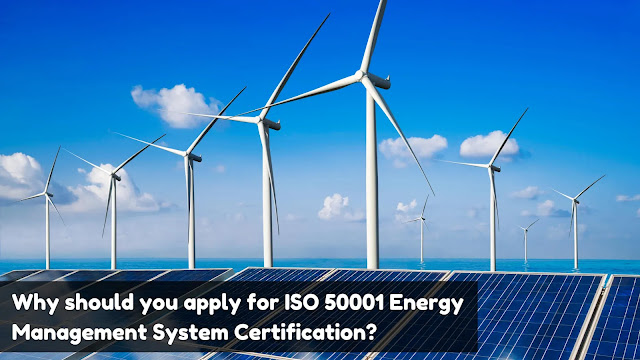Energy Management System: What Does It Imply?
ISO 50001 fulfills requirements for establishing, implementing,
maintaining, and upgrading an Energy Management System (EnMS). The purpose is
to set up an organization for accepting a method that is organized to achieve
consistent improvement in overall energy performance.
ISO 50001 is an
international standard that implies the use of Energy Management Standards. The
ISO 50001 Standard provides a framework for enterprises to analyze key areas of
power utilization, integrate energy savings into management procedures, and
facilitate continual improvement of energy efficiency.
The rise of energy prices and greenhouse emissions missions are a
problem for all companies. That’s why the demand for effective energy
management has received popularity.
Complying with the Energy Management System externally will
demonstrate to your stakeholders the true and courageous dedication of your
organization. The purpose is to energy savings, greenhouse gas reduction, and
company sustainability.
Energy Efficiency – What Does It Contribute to?
Energy efficiency is achievable with the proper use of an Energy
management system. An Energy Management System (EMS) aids in the monitoring and
control of energy use.
It makes an impact on the optimization of energy usage and the
reduction of energy expenditures. Real-time energy data from EMS systems can be
utilized to detect and correct energy inefficiencies, identify energy-saving
possibilities, and track energy use.
Energy-saving actions, such as scheduling HVAC and lighting systems or activating energy-efficient equipment at specific times. They can also be automated by EMS systems. EMS systems are the ones helping organizations and people to save money, lessen their environmental impact, and achieve sustainability goals by lowering energy use.
Reasons to Follow the Guidelines of ISO 50001 Certification
According to the ISO 50001 Standard,
energy efficiency is characterized as the ratio of a system's usable output to
its energy input. It measures how efficiently energy is used in a system.
Energy efficiency compares the amount of labor or energy output generated to
the amount of energy input necessary to create it.
In terms of definition, it is a way to evaluate how effectively
energy is used to achieve a particular goal. An organization's energy
efficiency is the act of minimizing the quantity of energy utilized in order to
decrease operating expenses.
It entails increasing the efficiency of machinery, operations, and
systems in order to use less energy to generate the same or better level of
output. Installing energy-efficient lighting, utilizing renewable energy
sources, and enhancing insulation are all examples of such actions.
Energy efficiency may additionally apply to the use of energy more
productively, for as by installing motion-activated lighting and regulating
thermostats to a specified temperature.
●
Facilitate
and transparent contact from power resource management.
A capitalized gateway or stage where all investors can access
energy-related data, such as updates on ongoing projects, reports on energy use
and performance, and other pertinent data, is one technique to facilitate and
make interaction from power resource management more visible.
●
Save
the Cost associated with Energy or Relevant Resources
The activities within the ISO 50001 Certification allow
enterprises for increasing energy savings, utilization, and usage
● Allow
Energy-Efficient Technologies
The use of ISO 50001 EnMS brings the liberty to the industries for
following, assessing, and prioritizing the use of energy-efficient new
technologies.
●
Improve
Energy Administration
The benefits of ISO 50001 include better energy security,
decreased energy costs, increased competitiveness, and improved environmental
performance. It is also responsible for denying the rise of greenhouse gasses
from the manufacturing unit of the industries.
●
Promote
Energy Management Policies And Practices.
The training programs of the ISO 50001 Certification lead to the
best practices among the employees and management of the organization. It
starts with developing fully-proofed Energy Management Policies to counter
different unhealthy practices properly.
●
Follow
Different Safety Measures
The use of ISO 50001 Certification allows the integration with
other organizational management, such as environmental, safety, and health. It
creates a different impact to form a well-developed industry while managing its
energy properly.
●
Encourage
Energy Reductions Throughout The Supply Chain.
With ISO 50001 Certification, an organization establishes a
framework suitable for concluding energy reduction measures. They are vital to
saving energy and cost at the same time.
Additional Support from the Energy Management System
This EnMS approach is continuous in order to focus on frequent
improvement. In accordance with ISO 50001
Certification, an Energy Management System, indicates that
energy requirements must be constantly upgraded and administered on a regular
basis.
● Aids
you in understanding your company's entire power usage and power utilization
procedures.
● Determines
the methods that represent total energy use.
● Identifies
and implements strategies for power preservation.
● Improves
performance, which results in considerable cost
savings.
● Encourages
energy efficiency in the supply chain.
● Evaluates
and follow unique new energy-efficient technology.
● Ensures
regulatory compliance with energy-related standards.
● Reduces
greenhouse gas emissions and the organization's carbon impact.
Integrates with current administration systems such as ISO 9001 Certification and ISO 14001 Certification.

No comments:
Post a Comment